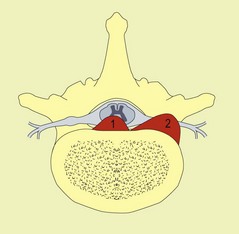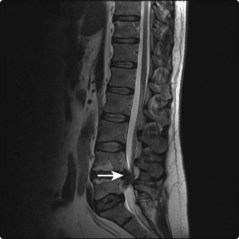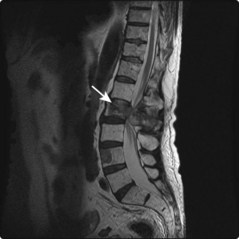Radiculopathy
Disease affecting the nerve roots is common. The most common sites of involvement are the lumbar spine (annual incidence of severe cases of 150 per 100 000) and cervical spine (annual incidence of 20 per 100 000).
Aetiology
Acute disc
This occurs in young individuals in the absence of other major degenerative spine disease. In acute presentations there is often a history of recent injury or straining, for example lifting. This results from herniation of the nucleus pulposis through a rupture in the annulus fibrosis, a so-called ‘soft disc’ (Fig. 1).
Other rarer causes
Tumours may cause radiculopathy at any level and may be primary nervous system tumours arising on the nerve root (e.g. neurofibroma or meningioma) or spinal bony metastases compressing the nerve root (Figs 2 and 3). Common sources of secondaries are tumours of breast, bronchus, prostate, kidney, thyroid and lymphoma. An apical lung tumour (Pancoast tumour) causes wasting of small muscles of the hand (T1) and a Horner’s syndrome.
Inflammatory conditions may cause radiculopathy; the most common is shingles (herpes varicella zoster virus) infection (p. 100). Rarely, radiculopathy can be due to inflammatory or malignant meningitis.







